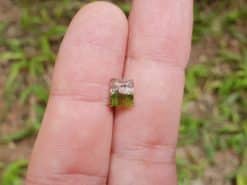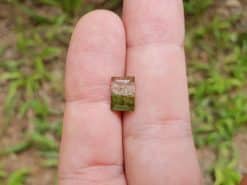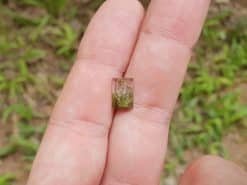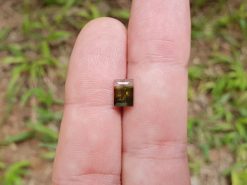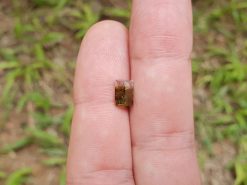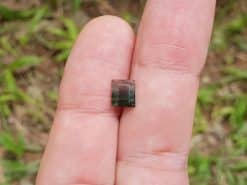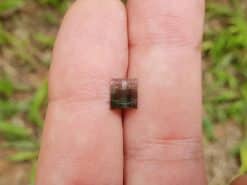Watermelon tourmaline
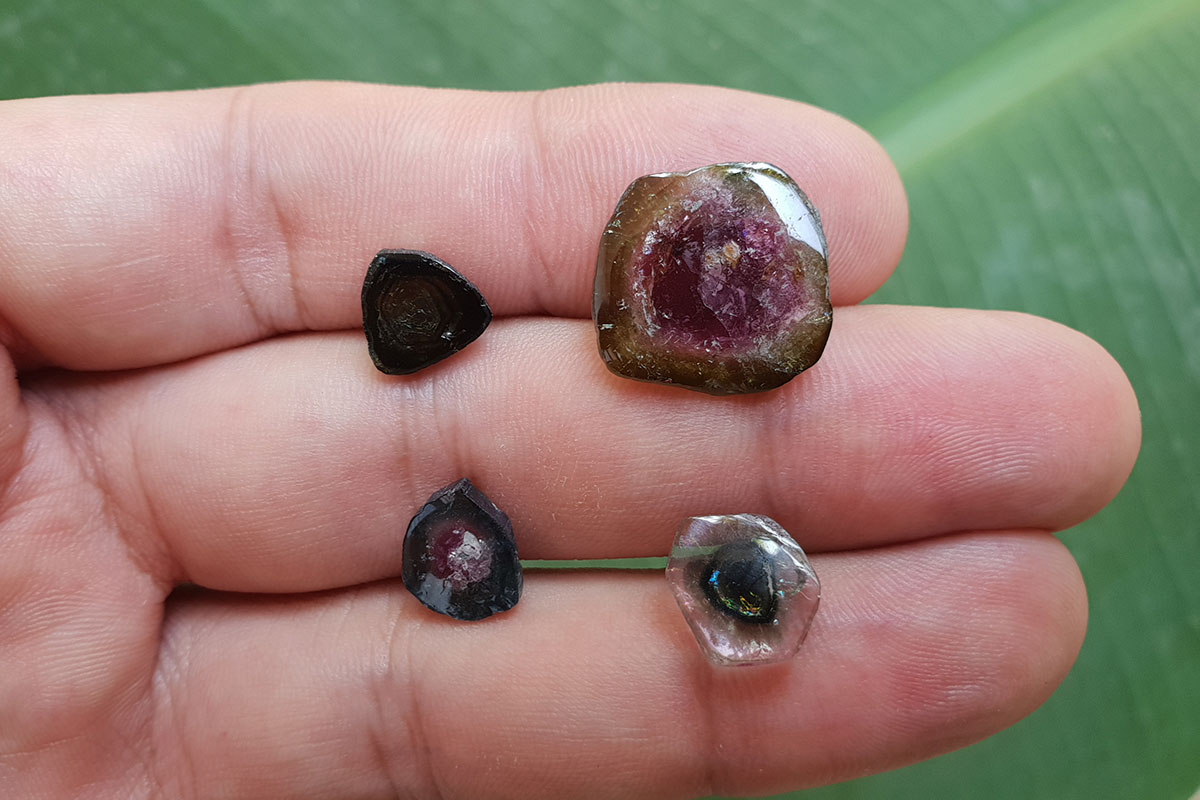
Buy natural watermelon tourmaline in our shop
Watermelon tourmaline stone
Watermelon tourmaline is a truly mesmerizing variety of color-zoned tourmaline that displays a remarkable combination of vibrant hues. Typically, this gemstone exhibits a pinkish-red center encased by a green outer rim, resembling the cross-section of a ripe watermelon. Unlike other bi-color or polychrome tourmalines that show longitudinal color transitions, watermelon tourmaline stands out due to its unique concentric zoning pattern. The green shades often appear as the crystal’s exterior, while the reddish core lies at the heart of the stone, creating a natural and visually captivating contrast.
This gemstone is part of the broader tourmaline family, which can include trace elements such as aluminum, iron, magnesium, sodium, lithium, or potassium. Watermelon tourmaline is classified as a semi-precious gemstone and is admired for its wide range of color variations and intensities. In fact, the name “tourmaline” itself is believed to derive from the Sinhalese word “thoramalli,” referring to a group of colorful gemstones first discovered in Sri Lanka. Over time, watermelon tourmaline’s distinctive appearance and intriguing history have contributed to its ongoing popularity among collectors, jewelers, and enthusiasts.
Watermelon tourmaline is also known as a form of elbaite, which is a sodium, lithium, and aluminum boro-silicate mineral. Its chemical composition can be expressed as Na(Li1.5Al1.5)Al6Si6O18(BO3)3(OH)4. This mineral belongs to the six-member ring cyclosilicate tourmaline group. Due to its structure and composition, the gem can display strong pleochroism, showing slight color variations when viewed from different angles. High-quality crystals can be transparent and lustrous, making them highly sought-after as centerpieces in fine jewelry.
Watermelon tourmaline slices
Elbaite
Elbaite forms several series: one with dravite, another with fluor-liddicoatite, and also with schorl. Because it forms series rather than a single ideal end-member composition, perfectly pure forms are practically non-existent in nature. Nonetheless, elbaite’s range of hues—especially in the watermelon variety—offers extraordinary visual appeal.
As a gemstone, elbaite has long been cherished for its brilliance, variety of colors, and overall crystal quality. Originally discovered on the island of Elba, Italy, in 1913, it has since been located in numerous deposits worldwide. A notable discovery occurred in Canada’s Yukon region in 1994, significantly increasing this stone’s availability to collectors. Though rare, the presence of watermelon tourmaline in various geographical regions attests to the gemstone’s broad geological distribution.
Raw watermelon tourmaline often forms within igneous and metamorphic rocks, as well as in mineral-rich veins. It is commonly found in granite pegmatites, frequently alongside minerals such as lepidolite, microcline, and spodumene. In some locations, it can also occur within schists, associated with minerals like andalusite or biotite, and in hydrothermal replacement deposits accompanied by molybdenite and cassiterite. These geological environments provide ideal conditions for the crystal’s growth, allowing complex color zonations to develop over time.
Elbaite, and by extension watermelon tourmaline, is considered allochromatic. This means trace elements within its crystal lattice can influence its color. As a result, even the slightest chemical variations may lead to subtle or pronounced color shifts. Some stones exhibit color zoning, where distinct regions within the same crystal present different hues, lending a dynamic visual element to cut stones. Others feature microscopic inclusions that can produce a cat’s eye effect when the material is polished into cabochons, creating a shimmer of light that glides across the stone’s surface.
Varieties
- Colorless: achroite variety
- Red or pinkish-red: rubellite variety
- Light blue to bluish green: Brazilian indicolite variety
- Green: Brazilian verdelite variety
- Watermelon tourmaline: features a reddish center and a green outer zone, often visible in cross-section slices. Its appearance strongly resembles the rind and flesh of a watermelon, setting it apart from other bi-color stones.
Gemological properties
- Category: Cyclosilicate
- Chemical formula: (Ca,K,Na, ▢)(Al,Fe,Li,Mg,Mn)3(Al,Cr, Fe,V)6
- Crystal system: Trigonal
- Crystal class: Ditrigonal pyramidal (3m)
Identification
- Color: Multicolor (notably green and pink/red in watermelon variety)
- Crystal habit: Parallel and elongated, often acicular prisms
- Cleavage: Indistinct
- Fracture: Uneven, small conchoidal, brittle
- Mohs scale hardness: 7 – 7.5
- Luster: Vitreous, sometimes resinous
- Specific gravity: 3.06 (+.20 -.06)
- Density: 2.82–3.32
- Polish luster: Vitreous
- Optical properties: Double refractive, uniaxial negative
- Refractive index: nω=1.635–1.675 / nε=1.610–1.650
- Birefringence: -0.018 to −0.040 (typically about .020, but may reach .040 in dark stones)
- Pleochroism: Typically moderate to strong, showing varying intensities of color depending on viewing direction.
- Dispersion: .017
- Ultraviolet fluorescence: Pink stones are inert to very weak red to violet in long and short wave
- Absorption spectra: Strong narrow band at 498 nm, nearly complete red absorption down to 640 nm in blue and green stones. Red and pink stones can show lines at 458 and 451 nm, plus a broad band in the green spectrum.
Watermelon tourmaline meaning and healing properties benefits
The following section is pseudo-scientific and based on cultural beliefs.
Watermelon tourmaline is frequently associated with emotional healing, inner peace, and spiritual growth. Within various metaphysical traditions, it is revered as a “gateway” to the inner self. This stone is thought to help cleanse and clear blockages, especially within the heart and higher heart chakras. By removing these emotional barriers, one may experience a deeper sense of compassion, empathy, and understanding. Some believe that wearing or carrying watermelon tourmaline can help alleviate stress, reduce fear, and encourage feelings of self-acceptance. Many who value the energetic properties of this gemstone suggest that it helps balance opposing energies, inspiring a harmonious flow between mind, body, and soul.
Beyond emotional relief, watermelon tourmaline is sometimes credited with inspiring creativity, encouraging a more uplifting perspective, and increasing vitality. Enthusiasts often recommend meditating with the stone, holding it near the heart, or simply placing it in a space where its gentle energies can be felt. The vibrant colors of watermelon tourmaline are said to symbolize the unity of contrasting forces—love and passion represented by pink/red, growth and renewal symbolized by green—making it a gemstone that can remind one of life’s interconnected patterns.
Bicolor tourmaline
FAQ
What is watermelon tourmaline good for?
Watermelon tourmaline is often celebrated for its perceived ability to inspire emotional harmony, reduce stress, and encourage self-confidence. Many who treasure it believe this stone can help open the heart chakra, promoting compassion, understanding, and a sense of inner joy.
Is watermelon tourmaline expensive?
Watermelon tourmaline with vivid, well-separated colors and good clarity is highly valued. Rare, clean stones weighing a few carats can command premium prices, often ranging from several hundred dollars to well over $500-$600 USD per carat, depending on quality and saturation.
Is watermelon tourmaline real?
Absolutely. Genuine watermelon tourmaline is a naturally occurring gemstone. Its captivating coloration might seem almost too perfect to be real, but these stones form naturally deep within the Earth. As with all gems, it’s prudent to purchase from reputable sources or seek professional verification.
What chakra is watermelon tourmaline associated with?
This gemstone is commonly linked to the heart chakra, where it is believed to foster emotional balance, compassion, and empathy. By supporting the heart chakra, watermelon tourmaline may help one release stress, embrace positive feelings, and deepen personal connections.
How can I identify a real watermelon tourmaline?
Authentic watermelon tourmaline typically shows a natural gradation between its green and pink zones rather than a sharp, artificial-looking boundary. Real stones often exhibit minor inclusions. If in doubt, consider consulting a professional gemologist or using our gemstone testing service for expert analysis.
Natural watermelon tourmaline for sale in our gem shop
We offer custom-made watermelon tourmaline jewelry, including engagement rings, necklaces, stud earrings, bracelets, and pendants. Each piece is crafted to highlight the gemstone’s inherent beauty and uniqueness. For more information or to request a quote, please contact us.

